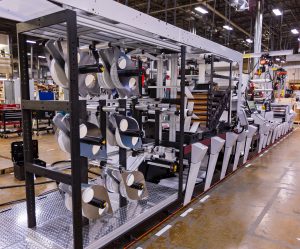More than just a pretty face!
Mark Andy makes the case for hardworking labels
To many people, a label is purely a decorative item used in a variety of different places to provide information, from supermarket shelves to pharmacies to logistics and various sectors of freight. Often described as ‘humble’, the label is the most universal item of packaging, so it’s no surprise that among its many attributes is the capability of performing under the harshest of conditions.
These include all types of weather and the full range of temperatures from freezing to hot and arid, as well as the high humidity of equatorial climates. In addition, labels must cope with abrasion and contact with, amongst others, sea water, blood, chemicals, and many others. So, do you still think they are purely decorative?
Fundamental to hardworking labels are a requirement for substrates that are stronger and of heavier gauge than standard labels and if they are pressure sensitive, the adhesive will need to be very aggressive to cope with sub-zero or beyond boiling point temperatures. In addition, the ink must be lightfast and suitable for harsh conditions with good adhesion, rub and scuff properties.
Phil Baldwin, Sales Manager for the UK, Ireland, and Scandinavia outlined the background to Mark Andy’s involvement with the sector: “The company has long supplied technology to this market and has extensive experience of applications from oil drum labels, wrist bands, and tree tags to animal carcass straps. Mark Andy’s chill drums not only chill the web but allow it to be heated, which improves handling when running aggressive adhesive material. The pre-tension web transport and Oldham coupling drives also ensure the press can handle special materials like Tyvek for wrist bands and plastic plant pot inserts. If required, it can also supply inline spot hot melt glue heads, laminators to apply glassine strips or protective films, RFID insertors and many other options.”
On the consumable side, Mark Andy digital inks have high lightfastness ratings and excellent adhesion, scuff, and rub properties. The ink used on the Mark Andy Digital Series HD hybrid press is also autoclave and boiling-water safe, tested for solvent resistance to ASTM 5402-06 (solvents, grease, oil, fats, alcohol, and blood), tape test approved to ASTM 3359, has 7-8 on the blue wool scale, meets rub, scuff, and abrasion tests to industry standard ASTM 5264-98, and carries UL 969 certification for durable label applications.
But there are other considerations that need to be taken into account because hardworking labels often require more than just ink on substrate. An RFID tag is an excellent example of this, and while the technology is not new, the American press manufacturer says that it is witnessing increased levels of automation in production processes across a variety of markets. For example, shops are requesting labels with RFID tags to speed up the sale process and provide the data to control the whole retail operation.
Speaking for the company, European Sales Manager Lukasz Chruslinski explained how Mark Andy became involved with this sector: “We started with logistics, shipping companies and pharmacies, which were all areas that have thousands of different factors and where precision was the number one criterion. We have designed and built Tamarac models, which we test on new platform configurations, and can also configure special one-off machines with RFID modules, flexo printing stations, inspection units and tag applicators, depending on the customer’s specific needs. At present, the most popular RFID labels are just 1 or 2 flexo colours, which means a very simple design, but in future we will see full colour labels with RFID tags.”
The retail sector potentially offers huge growth prospects for RFID, as witnessed by the significant increase in enquiries Mark Andy has taken over the past two years. With its strong technological background and vast knowledge base, the company is well placed to capitalise on this wave of demand. “Anywhere that automation becomes an established part of the workflow is a case for RFID tags – they offer better stock control, traceability, and are an ideal way of preventing counterfeiting. While the upfront cost of installing RFID technology may appear high, its payback is both quick and ongoing,” he concluded.
If its relevance were in doubt, the current situation, which sees inflation rising sharply and the cost of living increase proving difficult for people to manage, has seen leading retailers taking steps to secure some premium products from shoplifters. Phil Baldwin commented: One UK supermarket chain has taken to using security straps on a leading brand of butter. The straps have an inbuilt security tag to deter theft and make the item traceable. This is a great example of using RFID for secondary packaging.”
Far from ‘humble’, today’s labels are multi-functional, diverse in application, and most of all, hardworking. When these self-adhesive/pressure-sensitive products were first developed nobody could have foreseen how they would grow to become an inherent part of daily life from retail to medical to freight and security. Not just a pretty face then!

The addition of RFID tags is one of several ‘added feature’ options with Mark Andy presses as labels
become more complex and are required to be durable